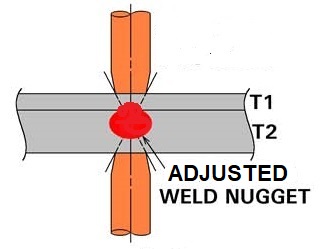
Spot Welding
Questions and Answers
Generally all spot welding electrodes are made from a copper alloy. During the resistance welding operations if their tensile strength is exceeded they will bend or collapse and fail from the mechanical force being exerted on them. RWMA Fig 18.3 in the RWMA Manual 4th Edition, shows the relationship of electrode weld face size, applied force and maximum capability.
Generally all spot welding electrodes are made from a copper alloy. During the resistance welding operations if their tensile strength is exceeded they will bend or collapse and fail from the mechanical force being exerted on them. RWMA Fig 18.3 in the RWMA Manual 4th Edition, shows the relationship of electrode weld face size, applied force and maximum capability. Similar information is shown in the following table.
Resistance welding tapers are precision tapers for attachment of electrodes to resistance welding holders. They are meant for quick and easy attachment and removal. If the weld forces used in the application are excessive for the size of the taper, the male taper can be driven into the female taper and ruin the tooling. Electrode removal may become difficult or impossible and further use of the holder is compromised. RWMA Fig 18.3 in the RWMA Manual 4th Edition, shows the relationship of electrode weld face size, applied force and maximum capability.
Heat balancing is adjusting heat input so that the nugget forms at the center or more importantly the faying surface. Resistance welding two different work piece materials will often cause the heat to build up in one before the other. The same is true if the thicknesses are unequal. This frequently leads to the nugget forming mostly in the hottest side of the part instead of at the faying surface.
A cosmetic weld is a resistance weld on a surface where a typical weld indentation would not be permitted. The middle of the hood of your car is a good example. Welds on medical instruments would be another case. To prevent these indentations from showing most of the heat input must be made from the other side of the part.

Generally “C” flat faced electrodes are used on the cosmetic side and care is taken to not over heat the part. Usually the weld nuggets are run in the lower range of the quality specification to reduce the heat affected area.
Reference RWMA Resistance Welding Manual 4th Edition
Page 43 of 44
Have a Question?
Do you have a question that is not covered in our knowledgebase? Do you have questions regarding the above article? Click here to ask the professor.
